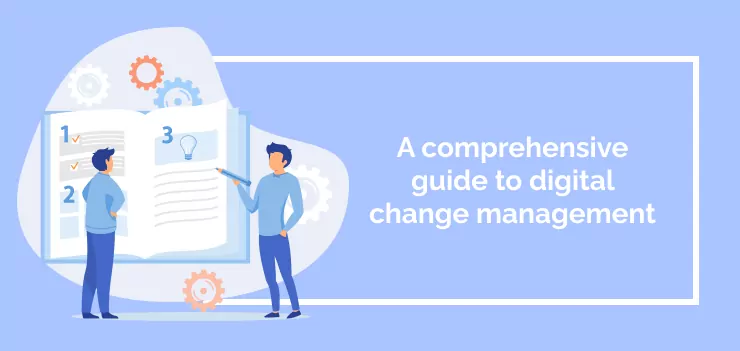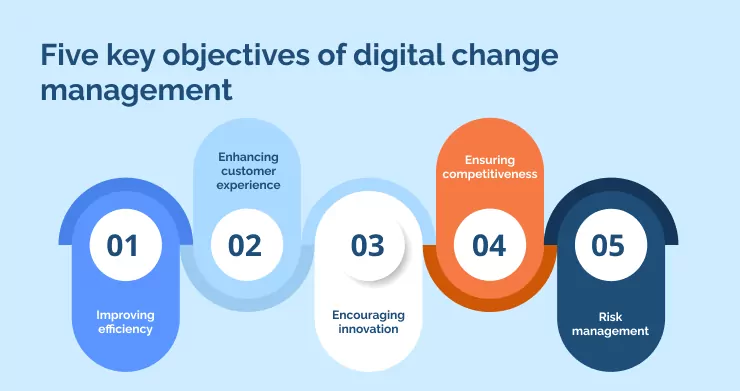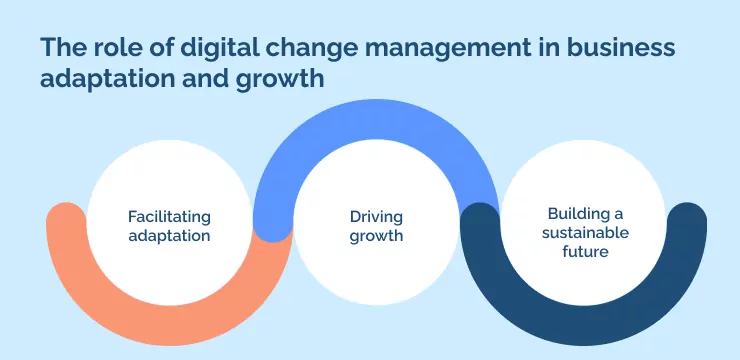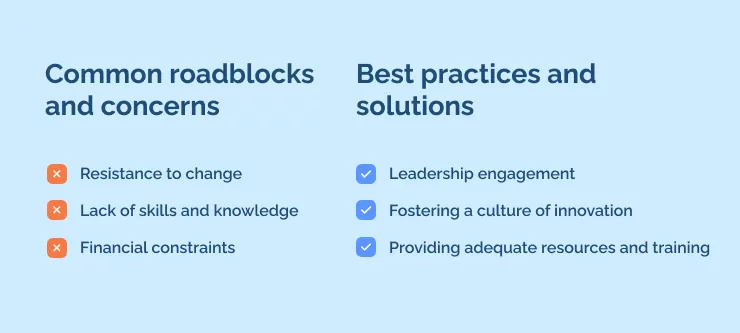
Digital change management is a structured approach that guides how your organization prepares, equips, and supports individuals to adopt digital technologies and new ways of working.
The goal is to successfully implement new digital processes, tools, and technologies as efficiently and painlessly as possible.
At its core, digital change management is about people and how they adapt to technological changes in your organization.
If you’re unfamiliar with digital change management, you could be doing yourself and your business a disservice.
47% of organizations that integrate change management are more likely to meet their objectives than the other 30% that did not incorporate it, so understanding the key elements is critical for any business leader.
But that’s easier said than done.
Only 34% of change initiatives succeed, and that’s in large part due to poor digital change management.
That’s why, in this article, we’re sharing everything you need to know about digital change management. From the basic elements all the way up to the common challenges you might face as you embark on your digital change management journey.
The importance of digital change management in business today
In an era where technology evolves at breakneck speed, staying competitive requires agility and adaptability.
With that in mind, digital change management is crucial for several reasons.
First, it enables your organization to keep pace with industry changes and customer expectations. As technologies such as artificial intelligence, big data, and cloud computing reshape industries, you must embrace them to maintain your edge.
Secondly, digital change management helps in enhancing the efficiency of business operations. By adopting new technologies, you can automate routine tasks, facilitate communication, and improve decision-making.
Moreover, your employees are central to the success of your digital transformation. Through digital change management, you can ensure your employees have the skills, knowledge, and tools they need to contribute effectively. This includes addressing resistance to change and helping employees understand the benefits of new technologies.
Understanding digital change management
First, let’s clarify the difference between traditional and digital change management.
Traditional change management generally focuses on the process of implementing changes in organizational structure, processes, or culture. It often involves a more linear approach and can be slower in nature.
On the other hand, digital change management is a subset of traditional change management but specifically focuses on changes related to digital technologies and processes.
It’s about embracing the fast-paced digital world. This requires a more agile approach, where you adapt quickly to technological changes and ensure your team is ready to use these technologies effectively.
For example, traditional change management might involve implementing a new company policy, while digital change management could be about integrating a cloud-based collaboration tool.
Five key objectives of digital change management

Now that you’re clear on what digital change management entails, let’s look at its objectives- what you’re trying to achieve with good digital change management.
The five main objectives of digital change management are:
Improving efficiency
By adopting new digital tools and technologies, you can streamline processes and automate routine tasks.
Enhancing customer experience
Digital change allows you to leverage analytics and AI technologies to understand your customers better and provide personalized experiences.
Encouraging innovation
It promotes a culture of innovation by empowering your team with the tools and knowledge needed to think creatively and solve problems.
Ensuring competitiveness
In a fast-paced world, staying ahead of the competition often means being the first to adopt and optimize new technologies.
Risk management
It involves identifying and mitigating risks associated with digital transformation, including security risks and compliance issues.
The role of digital change management in business adaptation and growth

Finally, let’s examine how digital change management plays a pivotal role in the transformation and growth of your business.
Facilitating adaptation
Digital change management helps your organization adapt to new market demands and technological advancements.
Through continuous learning and improvement, your business becomes more resilient to changes in the external environment.
Driving growth
Digital change management can contribute significantly to your bottom line by improving efficiency, customer satisfaction, and innovation.
The ability to quickly tap into new markets and meet customer needs drives business growth.
Building a sustainable future
As the digital era evolves, sustainability becomes more tightly linked to digital transformation.
Digital change management can help your business adopt environmentally friendly practices and create sustainable business models that align with the demands of modern consumers.
Understanding digital change management is crucial for successfully navigating the digital landscape. It not only supports your business adaptation but also fuels growth and sustainability.
Equipping your organization with the knowledge and tools for digital change management is an investment that will pay dividends in the long term.
Key elements of digital change management
A handful of key elements will form the backbone of your digital change management strategy.
These range from methods to tools to philosophies- but all are equally important in helping you make robust and swift digital changes in your business.
Every business will have different requirements, so you might not need to consider all of these elements. On the other hand, you may need things that aren’t listed here.
This is a good place to start to ensure you have everything you need for excellent digital change management.
Agile methodologies
In the context of digital change management, embracing Agile methodologies is vital.
Agile is all about being flexible, responsive, and adaptive to changes.
When you employ Agile methodologies, you break down your change initiatives into smaller, manageable pieces, allowing for rapid iterations and adjustments.
This approach ensures that you can swiftly respond to market changes and customer feedback without compromising quality or losing sight of your goals.
The Inherent Problem describes how the biggest waste of time in an organization is the requirement of leadership to approve decisions. Agile methodologies help you overcome that.
User experience and customer-centricity
Digital change management isn’t just about adopting new technologies; it’s also about ensuring these technologies serve your customers effectively.
A customer-centric approach means putting the customer’s needs and experiences at the heart of your digital transformation efforts.
This involves improving user interfaces, personalizing content, and ensuring changes enhance customer experience.
Cross-functional collaboration and communication
Digital change management often requires skills and knowledge from different areas of your business.
Encouraging cross-functional collaboration is essential for ensuring that changes are well-planned and executed.
Moreover, communication is key. Keeping all stakeholders informed about why changes are happening, what they entail, and how they will benefit the organization is critical for gaining buy-in and ensuring a smooth transition.
Digital tools and technologies
It just wouldn’t be digital without digital tools.
When it comes to digital change management, you’ll find that digital tools are both a goal and a tool.
At first, you’ll aim to adopt these digital tools. Then you’ll find that they help you drive further digital adoption.
Cloud computing
Cloud computing plays a pivotal role in digital change management.
With cloud computing, you can store and access data and applications over the internet rather than relying on physical hardware.
This technology not only reduces costs but also offers scalability and flexibility. It enables you to deploy new applications quickly and scale your operations without significant upfront investments.
Big data analytics
Big data analytics analyzes large and complex data sets to uncover patterns, trends, and insights.
By leveraging big data analytics, you can make data-driven decisions, optimize processes, and better understand your customers.
In the context of change management, it can help you monitor the impact of changes and make timely adjustments.
Artificial intelligence and machine learning
Artificial intelligence (AI) and machine learning (ML) are transforming the business landscape.
These technologies can automate tasks, provide insights through data analysis, and even interact with customers through chatbots.
In digital change management, AI and ML can help predict potential issues, optimize processes, and personalize customer interactions.
Challenges in digital change management- and how to overcome them

Digital change management isn’t easy if you’re not prepared.
To help you make sure you’re never caught out, let’s explore three major challenges you’re likely to face.
But it’s not all doom and gloom- we will also expand on three best practices to help you overcome those challenges.
Common roadblocks and concerns
Resistance to change
One of the most common challenges you might face in digital change management is resistance from your team.
People often find comfort in routine, and shaking up the status quo can lead to uncertainty and fear.
Lack of skills and knowledge
Implementing new digital tools and technologies requires specific skills and knowledge.
You may find that your current team lacks the expertise needed to effectively use these new technologies, which can hamper the change process.
Financial constraints
Digital transformation often requires significant investment in new technologies and training.
Financial constraints can be a major roadblock to implementing digital change for many organizations, especially smaller ones.
Best practices and solutions
Leadership engagement
Your leadership team’s support and engagement are crucial in overcoming resistance to change.
Leaders should be the champions of change, communicating the benefits and the vision.
When your team sees that the leadership is committed to the change, they are likelier to get on board.
Fostering a culture of innovation
Create an environment that encourages innovation and experimentation. Allow your team to take risks and learn from failures.
This culture of innovation can help ease resistance, as your team will be more open to trying new things.
It also helps bridge the skills and knowledge gap, encouraging employees to learn and grow.
Providing adequate resources and training
Allocating the necessary resources for digital change management is essential.
This includes not just financial investments in technology but also investing in your people.
Provide comprehensive training programs to upskill your employees. Moreover, consider seeking external funding or partnerships if financial constraints are a significant barrier.
Embracing digital change management for business success
Embracing digital change management is not just a modern trend; it’s a necessity for business success in the contemporary landscape.
As technology continues to evolve, the organizations that will thrive are those that can adapt swiftly and effectively.
By implementing digital change management, you’re positioning your business to be more agile, customer-centric, and innovative.
You’re improving internal processes and enhancing how you engage with and serve your customers. It enables you to tap into new markets, create value, and stay ahead of the competition.
Furthermore, in an era where data security and customer trust are paramount, digital change management ensures that your organization is vigilant and proactive in protecting its assets and reputation.
Digital change management is an invaluable tool in your business arsenal.
Understanding its components, implementing it strategically, and overcoming challenges pave the way for sustainable growth and success in the digital age.
WalkMe Team
WalkMe spearheaded the Digital Adoption Platform (DAP) for associations to use the maximum capacity of their advanced resources. Utilizing man-made consciousness, AI, and context-oriented direction, WalkMe adds a powerful UI layer to raise the computerized proficiency, everything being equal.



